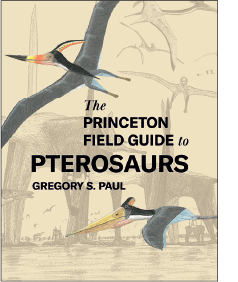


How to interpret a pterosaur
Gregory S. Paul 2022. The Princeton Field Guide to Pterosaurs. 184 pp. Princeton University Press. ISBN 978-0-691-18017-5. Price USD 29.95 (hardcover).
Pterosaurs ride the popularity wave alongside dinosaurs, with specialist illustrated encyclopaedias and guides surfacing across generations. The first all-encompassing and widely distributed pterosaur book, Dragons of the Air, by prolific early pterosaur researcher Harry G. Seeley, came out in 1901. This book set a precedent for pterosaur encyclopedias to come and still makes for an enjoyable read 120 years on. Pterosaur discoveries entered a bit of a dry spell lasting much of the 20th century, revived largely by prominent “pterosaurologist” Peter Wellnhofer and a compendium of his body of work, Illustrated Encyclopedia of Pterosaurs (Wellnhofer 1991). The most notable and all-encompassing book was released in 2013, Pterosaurs by Mark Witton—still the most cited hardback on flying reptiles (Witton 2013). With the Witton book still being largely up to date and no major status quo challenging discoveries, there was little demand for a new illustrated guide. The announcement of a new book from Princeton Press rose eyebrows within the (infamously argumentative) pterosaur community.
The author of The Princeton Field Guide to Pterosaurs, Gregory S. Paul, published on pterosaurs some time ago, albeit the author is more famed for his independent research on theropods and palaeoart, setting the precedent for skeletal reconstructions in the 90s. In 2010 Paul published the popular The Princeton Field Guide to Dinosaurs (Paul 2010), followed by similar guides focusing on marine reptiles and pterosaurs. So how did this dinosaur researcher tackle the entire specialist field of pterosaur research?
The book is sizeable, with thin but lustrous full-colour pages, a hardcover with a sleeve design (and formatting) on par with other “Field Guide” publications—it is a nice book to have on a desk. The inside of the book feels strictly academic and formal, which might deter some with casual interest. A lot of pages are dedicated to walls of small-font text fitted to the margins of the columns, which might pose a challenge for people with reading difficulties. More breaks in the long blocks of text, subsections, and illustrations could make the work more navigable. The book does not ponder on its clear-cut, and usually uncited, conclusions. For example, the author implies that rhamphorhynchoids are “more bipedal than pterodactyloids”, but does not cite a recent relevant work to back up this claim. Some conclusions derived by Paul are bookmarked with the authoritative statement “Any who disagree need to produce detailed restorations” which is an odd position to take in a guidebook aiming for wide distribution and would feel more at home in a discussion of an academic paper.
Paul also implements his own phylogenies, erecting clades like “Macronychoperans” or placing the disputed Anurognathus in “pterodactyliformes”. Pterosaur phylogeny is interpretative and variable, but Paul does not engage with exploring and explaining that uncertainty, opting for “a degree of personal choice and judgement” for his assessment. There is a difference between having pet theories or publishing these in academic papers, but a “most up-to-date and authoritative guide” that is meant to be an all-encompassing entry point for novices, might not be the place.
The book is filled with illustrations by the author, mainly the characteristic black side silhouette for skeletal reconstructions; and pencil drawings, varying from hybrid integration of drawing with photographs, to black and white reconstructions, to quality full-colour illustrations. I am especially fond of the Pterodactylus antiquus piece on page 126. The artist has a unique angular and dynamic style that is instantly recognisable. The side skeletal reconstructions are a highlight, including species and ontogenetic stages which never were officially illustrated, but sadly, the author does not mention which specimens are used for reconstruction, rendering it of little academic use.
The book rethreads formatting and content seen in Witton (2013) and other preceding books, including but not focusing on new discoveries that came since. Publishing large, illustrated books in the world of palaeontology is hard. These work as ambassadors of science, usually speaking the loudest to those who cannot be spoken to directly, people outside of the academic sphere. Scientific illustrated guides have a responsibility to be the best representation of the field. It is a shame that in this example, the book does not significantly push the barrier, is inaccessible with its text-heavy formatting, and refuses to collaborate with a wide array of academics in the field to create a solid, sturdy, intuitive but not certain, guide to these fascinating flying reptiles.
References
Paul, G.S. 2010. The Princeton Field Guide to Dinosaurs. 320 pp. Princeton University Press, Princeton. Crossref
Wellnhofer, P. 1991. The Illustrated Encyclopedia of Pterosaurs. 192 pp. Crescent Books, New York.
Witton, M.P. 2013. Pterosaurs. 291 pp. Princeton University Press, Princeton. Crossref
Natalia Jagielska [N.Jagielska@sms.ed.ac.uk; ORCID: https://orcid.org/0000-0001-7602-5878 ], School of GeoSciences, University of Edinburgh, Grant Institute, Edinburgh, EH9 3FE, UK.
Acta Palaeontol. Pol. 68 (2): 358, 2023
http://doi.org/10.4202/app.010702023